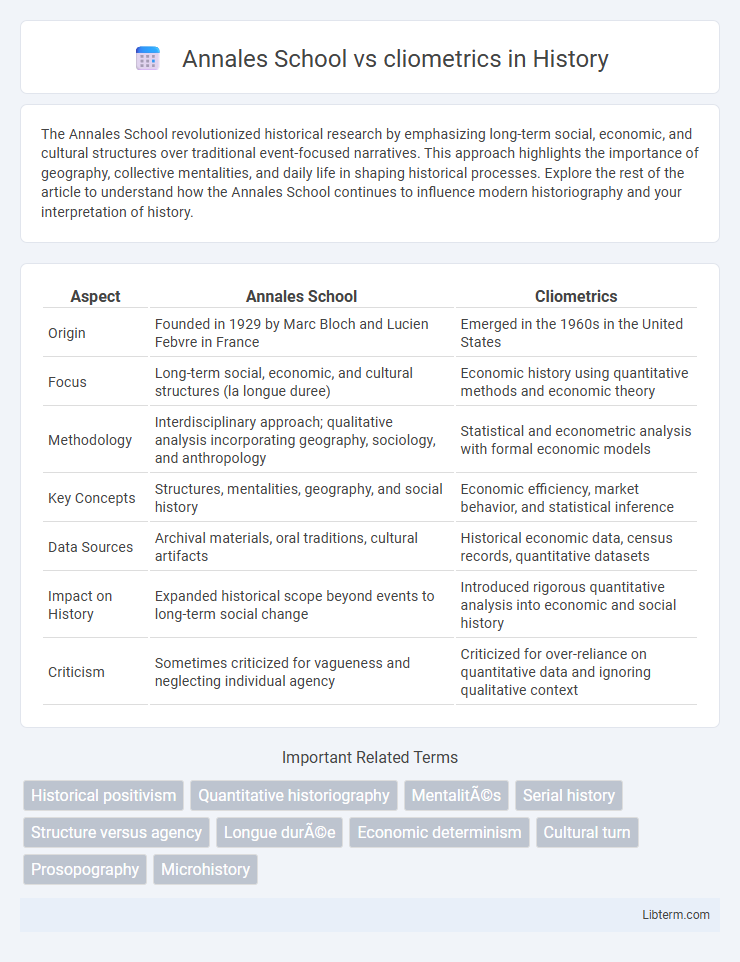The Annales School revolutionized historical research by emphasizing long-term social, economic, and cultural structures over traditional event-focused narratives. This approach highlights the importance of geography, collective mentalities, and daily life in shaping historical processes. Explore the rest of the article to understand how the Annales School continues to influence modern historiography and your interpretation of history.
Table of Comparison
| Aspect | Annales School | Cliometrics |
|---|---|---|
| Origin | Founded in 1929 by Marc Bloch and Lucien Febvre in France | Emerged in the 1960s in the United States |
| Focus | Long-term social, economic, and cultural structures (la longue duree) | Economic history using quantitative methods and economic theory |
| Methodology | Interdisciplinary approach; qualitative analysis incorporating geography, sociology, and anthropology | Statistical and econometric analysis with formal economic models |
| Key Concepts | Structures, mentalities, geography, and social history | Economic efficiency, market behavior, and statistical inference |
| Data Sources | Archival materials, oral traditions, cultural artifacts | Historical economic data, census records, quantitative datasets |
| Impact on History | Expanded historical scope beyond events to long-term social change | Introduced rigorous quantitative analysis into economic and social history |
| Criticism | Sometimes criticized for vagueness and neglecting individual agency | Criticized for over-reliance on quantitative data and ignoring qualitative context |
Introduction to the Annales School and Cliometrics
The Annales School revolutionized historical study by emphasizing long-term social, economic, and cultural structures over traditional political narratives, prioritizing interdisciplinary methods and quantitative data. Cliometrics, emerging in the mid-20th century, applies economic theories and statistical techniques to analyze historical events, particularly focusing on economic history and measurable trends. Both approaches transform historiography by integrating empirical data and broad analytical frameworks, yet the Annales School centers on qualitative structures while cliometrics centers on quantitative economic modeling.
Historical Context and Emergence
The Annales School emerged in the early 20th century in France, emphasizing long-term social history and structures over political events, challenging traditional historiography. Cliometrics, developed in the 1950s and 1960s primarily in the United States, applied quantitative methods and economic theory to historical analysis, marking a shift towards data-driven history. Both approaches reflected broader intellectual trends: the Annales School responded to interwar social changes, while cliometrics arose amidst postwar economic growth and advances in econometrics.
Core Philosophies and Methodologies
The Annales School emphasizes long-term social history, integrating geography, sociology, and economics to analyze collective mentalities and structures over centuries, relying heavily on qualitative sources and interdisciplinary approaches. Cliometrics applies quantitative methods, econometrics, and statistical models to historical data, focusing on economic history with a strong reliance on numerical evidence to test hypotheses and identify causal relationships. Core to the Annales methodology is the concept of "la longue duree," while cliometrics prioritizes rigorous measurement and formal modeling to explain historical phenomena.
Key Figures and Contributors
The Annales School, founded by Marc Bloch and Lucien Febvre, emphasized long-term social history and interdisciplinary approaches, with key contributors including Fernand Braudel, who expanded on geographical and economic structures influencing history. Cliometrics, pioneered by economists like Robert Fogel and Douglass North, applied quantitative methods and economic theory to historical analysis, revolutionizing economic history through statistical data and econometric modeling. Both schools transformed historiography, with the Annales School focusing on qualitative social patterns and cliometrics on empirical economic quantification.
Approaches to Historical Evidence
The Annales School emphasizes a multidisciplinary approach to historical evidence, focusing on long-term social, economic, and cultural structures through qualitative sources like archives, oral histories, and material culture. Cliometrics applies quantitative methods, leveraging econometric models and statistical data to analyze historical phenomena with a focus on measurable economic behaviors and outcomes. Both methodologies offer complementary insights, with the Annales School prioritizing depth and context while cliometrics stresses empirical rigor and data-driven analysis.
Quantitative vs Qualitative Analysis
The Annales School emphasizes qualitative analysis through long-term social history, favoring narrative and thematic interpretations over numerical data. In contrast, cliometrics applies quantitative methods and econometric models to historical data, promoting statistical rigor and empirical testing of hypotheses. This fundamental divergence shapes their respective approaches to understanding historical phenomena, with Annales prioritizing context and structure, while cliometrics highlights measurable economic and social patterns.
Contributions to Economic History
The Annales School revolutionized economic history by integrating interdisciplinary methods, emphasizing long-term social, geographical, and institutional structures over mere events or quantitative data. Cliometrics introduced rigorous quantitative techniques and economic theory into historical analysis, allowing for empirical testing of hypotheses and more precise measurement of economic phenomena over time. Together, these approaches expanded the scope and methodology of economic history, fostering a deeper understanding of economic dynamics within broader societal contexts.
Criticisms and Controversies
The Annales School faces criticism for its broad, interdisciplinary approach, often accused of neglecting rigorous quantitative analysis and overemphasizing long-term social structures at the expense of individual agency. Cliometrics, using econometric methods and formal models, is criticized for its reductionism, sometimes oversimplifying complex historical phenomena and ignoring cultural and social contexts. Debates between the two revolve around methodological differences, with controversies centered on the balance between quantitative precision and rich, qualitative narrative.
Influence on Contemporary Historiography
The Annales School revolutionized contemporary historiography by emphasizing long-term social structures, interdisciplinary methods, and the integration of geography, economics, and sociology to understand historical processes. Cliometrics introduced quantitative analysis and econometric models, transforming economic history through statistically rigorous studies of historical data. Together, these approaches shifted historiography toward more comprehensive, data-driven interpretations, blending qualitative and quantitative insights for a deeper understanding of historical change.
Comparative Legacy and Future Directions
The Annales School revolutionized historical studies by emphasizing long-term social, economic, and cultural trends through interdisciplinary methods, contrasting with cliometrics' quantitative focus on economic history using statistical models. While the Annales School fostered deep contextual analysis and broad historical perspectives, cliometrics introduced rigorous empirical validation and formal economic theory into historiography. Future research likely integrates Annales' holistic approaches with cliometric precision, leveraging big data and computational tools to enrich historical understanding and foster a more nuanced comparative legacy.
Annales School Infographic

 libterm.com
libterm.com